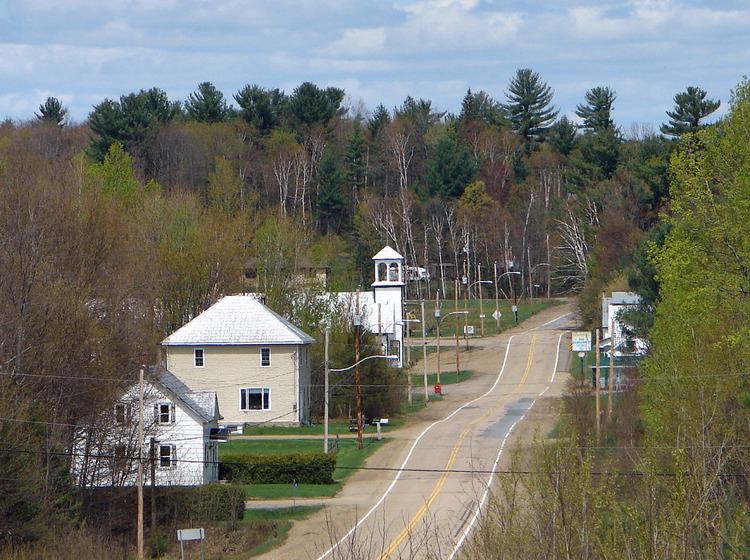Constituted January 1, 1869 Postal code(s) J0X 2Z0 Area 634 km² Population 130 (2011) Area code 819 | Time zone EST (UTC−5) Highways No major routes Local time Friday 9:33 PM Province Québec | |
 | ||
Weather 1°C, Wind E at 5 km/h, 93% Humidity | ||
Sheenboro is a village and municipality in the Outaouais region, part of the Pontiac Regional County Municipality, Quebec, Canada. It was formerly known as Sheen-Esher-Aberdeen-et-Malakoff. Its territory stretches along the north shore of the Ottawa River from Chichester to Rapides-des-Joachims.
Contents
Map of Sheenboro, QC, Canada
Because of its Irish heritage, Sheenboro retained the character of being a Little Corner of Ireland. Primarily dependent on farming and logging, it is also a popular location for tourism, swelling its summer population up to 500 persons. The Fort William Trading Post, including the factor's house and church, is a historical site and heritage village with a popular beach in the summer. It is also home to a sacred Algonquin burial ground.
Geography
The municipality is sparsely populated, with its population concentrated in the two communities of Sheenboro and Fort William, and along the Ottawa River, all in the south-eastern part of its territory. The isolated hamlets of Schyan Point, located at the confluence of the Schyan and Ottawa Rivers (almost across from Deep River, Ontario), and Fraser Landing, on the Ottawa River in Malakoff Township, are no more than a handful of seasonally-occupied cabins and have no paved road connection to them.
The remainder of the municipality is undeveloped Canadian Shield wilderness, most of which is part of a controlled exploitation zone. Its rugged terrain rises from about 110 metres (360 ft) above sea level at the hamlet of Fort William to over 180 metres (590 ft) at the village of Sheenboro, reaching 430 metres (1,410 ft) northwest of Trout Lake. Heading north from the hamlet of Schyan Point, the land rises gradually from 121 metres (397 ft) to the peak of Mount Martin at 411 metres (1,348 ft).
Notable lakes within the municipality include Dufoe, Esher, Manny, McCool, McGillivray, L'Oiseau, and Lackey Lakes, and numerous other bodies of water of lesser importance, such as Sheen, McDonald, Trout, Tremblay, and Greer Lakes.
History
In 1823 John Siveright, in charge of Fort-Coulonge, Quebec sent John McLean upstream to build a post at Lac des Allumettes. The post had to compete with many petty traders, including one who was already on the site. The post had its own farm and was able to grow some of its own food. By 1844 it was handling the bulk of the Indian trade in the region. Hector McKenzie was in charge from 1845 to 1864. He built an unusually large two-story house which is still standing. In 1848 a post office was established and the name changed from Lac des Allumettes to Fort William in honor of William McGillivray. It was a long-established custom for Indians to come to Lac des Allumettes to meet with Jesuits from Montreal and solemnize baptisms and marriages. Following this, a great feast was held. In 1857 the HBC built an Indian church. In 1869 the HBC sold Fort William for $3000 and moved its operations to Pembroke, Ontario. The site was on the north bank of the Chenal de la Culbute north of Allumette Island.
On the Gale and Duberger map of 1795, the Townships of Sheen, Esher, and Hastings are already shown, even though these townships would not be officially established until several decades later. Respectively, these townships were probably named after an English village in north Surrey County (now the London Borough of Richmond upon Thames), a residential suburb in south-west London, and the English town of Hastings. Hastings Township was renamed to Malakoff in 1856, commemorating the French victory in the Battle of Malakoff.
In the 1830s, Irish people, escaping famine and religious persecution, began to settle in the area and in 1848, a post office was opened in Fort William. In 1849, the Township of Sheen was established, and six years later the Township Municipality of Sheen was formed with Thomas Harrington as its first mayor.
In 1869, the townships of Esher, Malakoff, and Aberdeen became part of Sheen, forming the United Township Municipality of Sheen-Esher-Aberdeen-Malakoff. One year later, the Sheenboro post office was opened and a store and hotel was built by Michael Hayes. Shortly after in 1872, the St-Paul-the-Hermit parish church was built after the original church was destroyed by fire.
In 1960, the territory of the former Aberdeen Township was added to Rapides-des-Joachims, but the United Township Municipality retained its full name. In 1968, the post office in Fort William closed.
On October 11, 2003, the name and status of the United Township Municipality of Sheen-Esher-Aberdeen-Malakoff changed to become the Municipality of Sheenboro.
